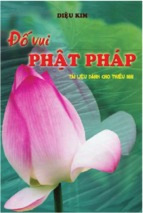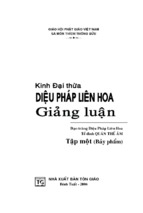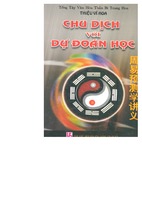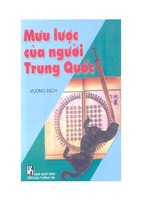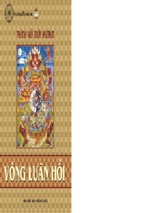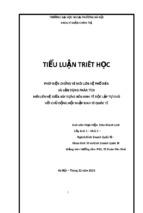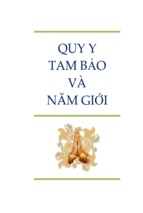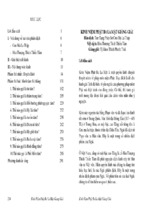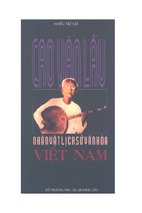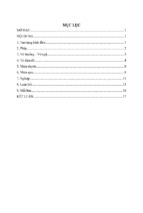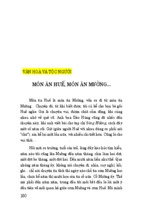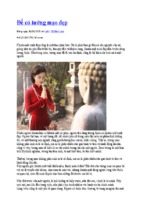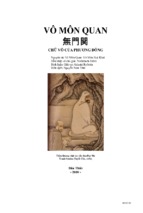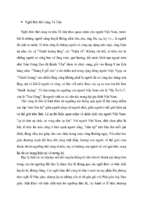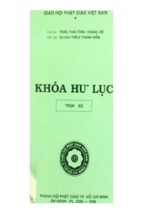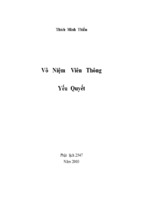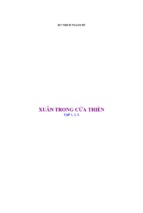TÍN TÂM MINH
TRUST IN MIND
THE THIRD PATRIARCH SENG-TS’AN
First Commentary:
The Most Venerable THÍCH THANH TỪ
TÍN TÂM MINH
TRUST
IN
MIND
Second Commentary:
Translated by:
Edited by:
Thuần Bạch
Thuần Tỉnh – Ngọc Bảo
Barbara Hillmer
- 2010 -
4
Tín tâm minh
LỜI DẪN
Nay tôi (Hòa thượng) giảng bài Tín Tâm Minh
của tổ Tăng Xán. Tổ Tăng Xán là tổ thứ ba, đệ tử của
nhị tổ Huệ Khả. Tổ không có đi truyền bá giảng dạy
sâu rộng, [vì Phật tử bị đàn áp], chỉ có một người đệ tử
thừa kế là ngài Đạo Tín.
Tổ chỉ để lại có một tác phẩm Tín Tâm Minh,
một bản văn rất gọn và đầy đủ ý nghĩa trong nhà thiền.
Học thiền, chúng ta học Pháp Bảo Đàn mà không học
Tín Tâm Minh là không được. Tổ tóm gọn tinh yếu của
Thiền qua bao nhiêu lời, bao nhiêu chữ, đề tựa là Tín
Tâm Minh. Tín Tâm là tin tâm mình. Minh là ghi khắc
lại cho người đọc nương theo tu tập để nhận ra tâm
mình.
I. TÍN TÂM KHÔNG HAI
1. Chí đạo vô nan
Chí đạo không khó
2. Duy hiềm giản trạch Chỉ hiềm lựa chọn
Chí đạo có chỗ gọi là chân tâm, Phật tánh, Đại
đạo. Đối với Phật tánh, chúng ta muốn sống được
không phải khó. Sở dĩ khó là tại chúng ta chọn lựa,
nghĩa là đối với cảnh liền sanh tâm phân biệt tốt - xấu,
hay - dở… là trái với đạo rồi.
Chúng ta muốn sống được với tâm thể chân thật
chỉ đừng khởi tâm phân biệt chọn lựa, vì chọn lựa là
tâm hư vọng. Nếu không sống với tâm hư vọng thì tâm
chân thật hiện ra.
Trust in Mind
5
INTRODUCTION
The following is a commentary on “Trust in Mind”
(Hsin Hsin Ming), a treatise written by Seng-ts’an the third
Zen patriarch after Hui-k’o. Hui-k’o received the transmission
from Bodhidharma, the first Zen patriarch of China. During
his lifetime, because Buddhists were being persecuted,
Seng-tsan could not teach the Dharma freely, and he had only
one disciple who received the transmission from him. That
disciple was Tao-hsin.
The only writing left by Seng-tsan was “Trust in
Mind,” a brief writing in verse which expresses the main
meanings of Zen. To learn Zen Buddhism, we study the
Platform Sutra, but we must also study “Trust in Mind.” All
of the essence of Zen is contained in the words and verses of
this short writing. Hsin Hsin means to have faith in our own
mind. Ming means to note, to inscribe this treatise for the
purpose of guiding readers in their practice following the
path towards enlightenment.
I. CULTIVATING A NON-DUAL MIND
1. The Ultimate Way is not difficult
2. For those who have no preferences
The Ultimate Way is also called by other names such
as the Great Way, Buddha nature, the true essence, etc. It’s
not impossible for us to realize our Buddha nature and live
our lives by it, but because we always discriminate and have
preferences whenever we meet the objects of our senses, it
becomes difficult.
A discriminating mind, always debating what is good
or bad, right or wrong, is a deluded mind. Our discriminations
take us away from the Way. If we let go of this deluded mind,
our true essence will become apparent.
6
Tín tâm minh
Tam tổ Giám Trí Tăng Xán (526-606), tên Tăng
Xán có nghĩa “viên ngọc của Tăng-già.”
Ngoài bài Tín Tâm Minh, tổ chỉ còn một lời dạy
duy nhất khắc trên viên đá tri niệm là: ‘Đồng thời tu tịch
và chiếu. Quan sát miên mật, nhưng thấy không pháp,
không thân và không tâm. Bởi vì tâm không có tên tuổi,
thân là không và pháp là hư huyễn. Không có gì để được,
không có giác ngộ để chứng. Đây gọi là giải thoát.’
Tịch là dù đi dù đến đều tĩnh lặng và sống trong
chánh định (Không), trong đó có chiếu tức huệ (nền
của cái Không). Trong khi tà định có thể có thần thông
nhưng không có huệ.
Chúng ta có thể chứng nghiệm Đạo nơi khoảng
lặng giữa hai niệm tưởng. Đạo luôn hiện hữu, chưa bao
giờ rời xa chúng ta, chỉ vì tham-sân-si che đậy nên chúng
ta không nhận ra.
Tín “信” - chữ Hán có bộ nhân đứng “亻” - có
nghĩa là đặt niềm tin vào chính mình – tin tâm mình là
Phật và tu tập để trực tiếp chứng nghiệm Phật tâm bằng
trực giác là trí Bát-nhã, và niềm tin kiên cố sẽ đến từ
chứng nghiệm này. Lòng tin là bước đầu tu tập và qua tu
tập chúng ta đạt được trí tuệ. Trí tuệ này sẽ tăng trưởng
lòng tin đến khi giác ngộ. Như kinh Niết-bàn nói ‘Đại
tín không gì khác hơn là Phật tánh.’
Trust in Mind
7
The Third Patriarch was Seng-ts’an ( Jianzhi
Sengcan 526-606). His name means the “Jade of
Sangha.”
Apart from “Trust in Mind,” his only teaching, carved
on the stone tablet at his memorial, says, “Simultaneously
practice Stillness and Illumination. Carefully observe, but
see no dharmas, see no body, and see no mind, for the
mind is nameless, the body is empty, and all dharmas are a
dream. There’s nothing to be attained, no enlightenment to
be experienced. This is called liberation.”
“Stillness” is silently going and coming and
being in Right Samadhi (empty mind) and within it
there is “illumination” (wisdom) that is the ground of
Emptiness. False Samadhi is that stillness whereby we
may gain supernatural powers but not wisdom.
We can realize the Way in the interval of stillness
between two thoughts. The Way is ever-existing,
and never far from us, but we cannot recognize the
Way because it is obscured by Greed, Anger and
Unawareness.
Within the Chinese character “信” (Hsin - Trust)
there is the ideogram “亻” as the person standing upright,
with self-assurance. This trust in the mind is directly
experienced through intuition, which is Prajna Wisdom,
and a strong conviction coming out of that experience.
Faith is the beginning of practice and through practice we
attain wisdom. This wisdom will make our faith increase
until we become enlightened. As the Sutra of Mahanibbana
says, “Great faith is nothing else than Buddha Nature.”
8
Tín tâm minh
3. Đản mạc tắng ái
Chớ khởi yêu ghét
4. Đỗng nhiên minh bạch Rỗng suốt minh bạch
Yêu ghét là gốc của sanh tử luân hồi, hết yêu ghét
thì tâm rỗng rang, sáng suốt.
Không cần tìm kiếm đâu xa, không phải lên núi
cao, vào rừng rậm mới có đạo, mà chỉ dứt sạch tâm
chọn lựa, buông được cái yêu ghét thì đạo hiện tiền.
Yêu ghét chỉ cho phân biệt đối đãi, như sách Thanh
Tịnh Đạo (Visuddhimagga) trong kinh Nguyên thủy
nói: ‘Hạnh xả là thấy tất cả chúng sanh bình đẳng.’
Khi tu hạnh xả, ta buông bỏ đặc trưng phân biệt
của ý thức, trong khi đặc trưng sai biệt của ý thức sẽ
chuyển thành trí sai biệt trong tính bình đẳng (không
phải là đồng đẳng), và toàn bộ ý thức chuyển thành
diệu quan sát trí.
5. Hào ly hữu sai
Sai lạc đường tơ
6. Thiên địa huyền cách Đất trời xa cách
Nếu sai chừng một hào một ly thì cách xa bằng
trời với đất. Đối với việc tu hành chúng ta phải hiểu
đến cội gốc, chớ khởi niệm tìm cầu Niết-bàn, tìm cầu
chứng đắc. Vừa khởi niệm tìm cầu là sai, là cách xa
Đạo bằng trời với đất.
Trust in Mind
9
3. If you have no likes or dislikes
4. You will clearly undisguise everything
To like and dislike, or to love and hate is the root of
our birth and death cycle. If we have no love or hatred, and
no likes or dislikes, our minds will be empty and clear.
You need not go far away to the mountain or the deep forest
to search for the Way. You need only to get rid of your choosing
mind, to let go of your likes and dislikes. Then the Way will be
right here with you.
Likes and dislikes denote discrimination, as the
Visudhimagga, the classical compendium of Theravada
teachings, defines it: “The function of Equanimity (the
sameness or oneness of mind) is to see equality in all
beings and phenomena.”
In practice, when we let go of the discrimination
aspect of mind-consciousness, the differentiation aspect of
mind-consciousness will be transformed into differentiationwisdom in the equality (but not identicality) of the mind, and
the whole mind-consciousness will be transformed into the
wisdom of wondrous observation.
5. If you make the slightest distinctions
6. You will be as far from the Way as Heaven is
from Earth
Even the slightest deviation from correct practice will
take you away from the Way as far as Heaven is from Earth.
If you want to practice the right Way, you have to understand
the root teachings of Buddha. Do not follow in your search
for Nirvana or enlightenment, because as soon as the idea
that you can search for Nirvana arises or you try to attain
the Way, you will deviate from the Way as far as Heaven is
from Earth.
10
Tín tâm minh
Khi học Phật trên nhiều phương diện, giống như
nhiều nhánh ngọn của một cội cây, chúng ta cần tìm
hiểu tận gốc rễ lời dạy của đức Phật. Trong thực hành
thì phải nắm vững pháp tu chính yếu không được lơi
lỏng, trong đó phải đặt niềm tin tuyệt đối vào vị thầy.
Tu trong tịnh: Buông vọng, nhưng không chế ngự
đè nén, vì như thế sẽ gây ra xung đột thì càng xa đạo.
Chỉ cần “nhìn” vọng tưởng, vì vọng tưởng vô thường
nên sẽ tự tan. Nếu không được, có thể quán vọng tưởng
là giả là không, hoặc truy nguyên hỏi nó từ đâu đến.
Câu hỏi sẽ giúp chúng ta tách rời vọng tưởng. Tránh
phân tích lý luận để biện minh sẽ đưa đến ‘nói thầm’, lại
sanh thêm vọng tưởng khác.
Tu trong động: Trong đi-đứng-nằm-ngồi, mọi
thời mọi chỗ, cần chú tâm nhất niệm.
Tu trong lúc làm việc: Tránh khởi niệm từ cực
đoan làm cho nhanh cho xong hoặc làm cho tốt cho
hay, sang cực đoan làm miễn cưỡng câu giờ.
Khi nhất niệm công việc tự hoàn chỉnh tối đa
theo sức mình, sẽ không quá ưa thích hay quá bực bội.
Từ đó sẽ khởi phát được định tâm và tỉnh giác.
Trust in Mind
11
In studying the various aspects of Buddhism,
which are similar to the multiple branches of a tree, we
must remember to follow them back to the source, the
root teachings of Buddha. In our practice also, we need
to have a thorough grasp of the essential guidelines and
not allow ourself to be distracted from our method. We
should have the utmost trust in our Master.
Practice on the cushion: Let go of all wandering
thoughts without any control or pressure. Oppression
will create conflict, hence far from the Way. We only need
to watch the thoughts; due to their impermanence, they
will dissolve by themselves. If this is not successful, then
observe that all thoughts are not real and are empty, or
question where they come from. The question will help us
to detach from the thought. Avoid analyzing or reasoning,
looking to justify ourselves, which leads to “internal
chatting,” thus creating more wandering thoughts.
Practice in motion: Stay with one-pointedness in
four movements - walking, standing, reclining, sitting in every time, every place.
Practice in working: Avoid following the two
extremes: trying to work as fast or as well as possible
and working reluctantly, playing for time.
With one-pointedness, the work will be
accomplished by itself depending on our own capacity.
We will feel neither angry nor attached; from this come
samadhi and awareness.
12
Tín tâm minh
7. Dục đắc hiện tiền
Muốn được hiện tiền
8. Mạc tồn thuận nghịch Chớ thuận chớ nghịch
9. Vi thuận tương tranh Thuận nghịch tranh nhau
10. Thị vi tâm bệnh
Đó là tâm bệnh
Cuộc đời có khi theo ý mình (thuận) hoặc trái ý
(nghịch). Ngay khi thành kiến – đuổi theo hoặc chống
báng – nổi lên, tâm trí sẽ mờ tối. Từ đó nội tâm phát sinh
‘nói thầm’ và kiến chấp đưa đến xung đột, bất an. Buông
bỏ thành kiến, tâm trí sẽ sáng suốt và chúng ta sẽ nhìn sự
vật như chúng đang là, không lệch lạc biến dạng.
Vừa thấy đây thuận kia nghịch chống đối nhau, đó
là tâm bệnh chớ không phải Đạo, không phải Thiền.
Tâm bệnh này ngăn cản sự tu. Khi tâm chúng ta
qua khỏi ‘nói thầm’ sẽ tĩnh lặng, trí huệ tức là Phật tánh,
vì có sẵn, sẽ thắp sáng.
15. Lương do thủ xả
16. Sở dĩ bất như
Bởi do lấy bỏ
Vì thế chẳng như
Muốn tâm mình “Như” thì đối với tất cả pháp
đều không lấy, không bỏ.
Chân như các pháp là lẽ thật luôn tròn đầy, không
được cũng không mất, nên không có gì để lấy cũng như
để bỏ.
Xem kệ của Bàng cư sĩ.
Trust in Mind
13
7. If you wish to see the Way
8. Hold no opinions for or against anything
9. To set up what you like, against what you dislike
10. Is the disease of the mind
Life is sometimes favorable or unfavorable to our
wills. As soon as opinions – for or against - arise, our
minds will become clouded. Therefore our internal
chatting and our attachment to our opinions will bring
about conflict and trouble. Get rid of our opinions, our
minds will be clear and we will see all phenomena as
they are, without deviation or distortion.
If there is a battle in your mind between what you like
and dislike, your mind is a diseased mind, not a Zen mind.
That unhealthy state of mind will obstruct our
practice. If we can overcome internal chatting, our
minds will be at peace. Wisdom or Buddha nature, as
they are intrinsic, will illuminate.
15. Because of our grasping and rejecting
16. We do not realize the Way
If we want to see things as they are, just release our
discriminating mind – attached or rejecting.
The Way or true suchness of all phenomena is the
ultimate and perfect truth, no gain no loss, nothing to
take or let go.
See Layman P’ang’s Verse.
14
Tín tâm minh
17. Mạc trục hữu duyên Chớ đuổi duyên trần,
18. Vật trụ không nhẫn Cũng đừng chấp không
19. Nhứt chủng bình hoài Cái Một bình đẳng
20. Dẫn nhiên tự tận
Tự yên tự dứt
Đừng chạy theo cái có, đừng chạy theo cái không.
Có và không đều chẳng kẹt chẳng mắc thì tâm được an
ổn bằng phẳng, dứt hết mọi điên đảo rối ren, tự nó dứt
sạch, tự nó an ổn.
Đủ duyên thì có trần cảnh. Tuy tiếp duyên xúc cảnh
nếu chúng ta tỉnh giác sẽ không đuổi theo. Tuy không
còn thức phân biệt, nhưng trí sai biệt của diệu quan sát
trí vẫn tác dụng trong mọi sinh hoạt.
Hết duyên thì không còn cảnh. Cái không này đối với có là không ngơ trong cặp đối đãi có / không cũng như khái niệm về tánh không thì không phải là cái
Không chân thật. Cái Không chân thật (chân không) –
vốn sẵn có nơi mọi chúng sanh và nơi các pháp - là tâm
thái tuy vô niệm mà linh hoạt và thường biết rõ ràng ở
tất cả mọi thời.
Xem vấn đáp giữa Huệ Khả và tổ Đạt-ma.
21. Chỉ động qui tịnh Dừng động về tịnh
22. Chỉ cánh di động
Dừng đó lại động
Dừng cái động để về cái tịnh, cái dừng đó lại
càng thêm động. Niệm vừa dấy lên liền đè nó xuống,
niệm trước vừa dừng, niệm sau lại càng dấy khởi.
Trust in Mind
15
17. Don’t pursue conditioned existence
18. Nor abide in emptiness
19. If you realize the Oneness and Equality of all
things
20. Your confusion vanishes
Do not be attracted by conditioned phenomena,
nor cling to the idea of emptiness; do not pursue
thoughts of this side or that side, “being” or “nonbeing.” Then your mind will be still and all the confusing
thoughts will disappear by themselves.
If conditions are favorable, phenomena exist.
If we are aware when we are in contact with all
phenomena, we are not attached to them. There’s
no longer discriminating mind-consciousness, but
the differentiating mind of the wisdom of wondrous
observation is still functioning in all activities.
If conditions are unfavorable or terminated,
phenomena are not being. Non-being refers to the blankness
in the duality “non-being / being” and the concept of
Emptiness refers to the intrinsic nature of human beings
and all phenomena. Neither one is True Emptiness. True
Emptiness, a no-thought state of mind, is alert and aware
at all times.
Read the
Bodhidharma.
conversation
between
Hui-k’o
and
21. If you seek stillness by stopping all activity
22. Then the effort to be still is activity itself
If you try to be still by suppressing all your thoughts,
then there are more movements in the stillness itself. As soon
as one thought is suppressed, the next thought arises.
16
Tín tâm minh
Người tu thường thường mắc hai cái lỗi. Một là
buông thả, hai là kềm giữ. Buông thả là phóng tâm theo
cảnh, kềm giữ là không cho chạy theo cảnh. Chỉ nhè nhẹ,
nhè nhẹ biết, không theo niệm là được rồi.
Khi có nỗ lực để dừng cái động, thật ra ta đã khởi
sự tranh đấu đi tìm cái đối nghịch là tịnh để giải tỏa,
giống như lấy đá đè cỏ không cho mọc. Khi lấy đá ra thì
cỏ càng mọc mạnh hơn.
Khi tu chúng ta chỉ cần giữ tâm tập trung vào
pháp tu càng lúc càng chuyên sâu – trở về đếm hơi thở
hay tham công án chẳng hạn - cái động tự dứt.
23. Duy trệ lưỡng biên
Chỉ kẹt hai bên
24. Ninh tri nhứt chủng Đâu biết cái Một.
25. Nhứt chủng bất thông Cái Một chẳng thông
26. Lưỡng xứ thất công Hai chỗ mất công
Vì kẹt hai bên có - không, phải - quấy... đâu biết
có cái Một, là cái chân thật.
Tất cả chúng ta đều sống trong đối đãi, nên không
thấu lẽ thật. Càng chạy theo cái không thật thì càng phí
sức uổng công, buông được hai bên là trở về với Đạo.
Cái Một hoặc là cái thấy bình đẳng tạo cho tâm sự
bình ổn, hài hòa, cân bằng và tròn đầy ngay trong lòng
nhị nguyên đối đãi mà chúng ta gán cho các pháp. Từ
cái thấy này chúng ta tu hạnh tùy thuận ‘Ở bầu thì tròn,
ở ống thì dài.’
Trust in Mind
17
In meditation the practitioner often makes two
mistakes: indulging or repressing. Indulging is getting
carried away by thoughts; repressing is pushing them away.
Only watch and be aware of your thoughts.
When there is an attempt to stop the myriad
activities of the mind, we are indeed fighting for the
opposite, which is peace to get free of ourselves. It is
as if we place a stone on the grass and press it down to
prevent the grass beneath it growing. When the stone is
removed, the grass will grow more rapidly.
In practice, we only need to concentrate our mind
on the method more intensively – return to counting
the breath or investigate the Ko-an, for example - and
mind activities will automatically stop.
23. When you hold on to opposites
24. How you can recognize Oneness?
25. If you do not realize Oneness
26. You will be imprisoned in duality and
waste your effort
Because we are attached to the two extremes (assertion
/ denial, right or wrong…) we won’t be able to see the Oneness
which is the Truth.
As long as we still are entangled in the False, we will
waste our effort. Let go of two extremes and the Truth is
right here and right now.
Oneness or the undiscriminating view brings
stability, harmony, good balance and peace to the mind
in the midst of the so-called dualities which we ascribe
to all phenomena. In this view we practice acceptance:
“In a gourd we are round, in a pipe we are long.”
18
Tín tâm minh
Tu thiền diễn biến tuần tự như sau: Từ tán tâm đi
đến nhất tâm tức cái Một (tu trong động), rồi đến vô
tâm hoặc vô niệm (tu trong tịnh).
41. Nhị kiến bất trụ
Hai kiến chẳng trụ
42. Thận vật truy tầm Dè dặt (chớ) đuổi tìm
43. Tài hữu thị phi
Vừa có thị phi
44. Phân nhiên thất tâm Lăng xăng mất tâm
Người biết tu thì ít nói phải ít nói quấy. Điều đó
người xưa có câu ‘Biến sắt trở thành vàng ngọc còn dễ
hơn khuyên người ta bỏ nói phải quấy.’
59. Bất kiến tinh thô
Chẳng thấy tinh thô
60. Ninh tâm kiệt đảng Định kiến lặng dứt
Nếu mình không còn thấy đẹp (tinh) xấu (thô) thì
chúng ta sạch hết mọi loạn tưởng lăng xăng.
Trong thực hành tinh hay thô chỉ cho sự tu sâu
hoặc cạn.
85. Mê sanh tịch loạn
86. Ngộ vô hảo ác
Mê sanh tịch loạn,
Ngộ không tốt xấu
Do mê, sanh ra phân biệt chấp trước, cho đây là
loạn động kia là tịch tịnh. Ngộ rồi thì không còn thấy
tốt xấu hai bên nữa.
87. Nhứt thiết nhị biên Tất cả hai bên
88. Vọng tự châm chước Do vọng châm chước
Tất cả cái thấy hai bên đều do phân biệt mà ra cả.
Trust in Mind
19
Zen practice consists in moving from distracted
mind to one-pointed mind in daily activities, and to nomind on the cushion.
41. Do not abide in the dualistic state
42. Avoid such pursuits carefully
43. If you make right or wrong
44. Your mind will be lost in confusion
So the practitioner should be careful and avoid
those dualistic situations. In reality, discrimination is a
hard-to-cure disease, therefore there is an old saying, “It’s
easier to make iron turn into gold than to stop people from
discriminating.”
59. If you do not distinguish refined and coarse
60. You will be free of prejudice and opinion
If you do not discriminate or have a dualistic view
on things, like beautiful or ugly, coarse or fine, your mind
will be cleared from all the defilements of prejudice and
opinions.
Coarse and refined in practice refer to beginning
and advanced levels.
85. Rest and unrest derive from illusion
86. With enlightenment there is no like or dislike
A deluded mind clinging to the illusion creates
feelings of rest and unrest, peace and agitation. But
an enlightened mind does not discriminate and is not
affected by likes and dislikes.
87. All dualities arise
88. From ignorant inference
Dual views arise from the discriminating mind.
- Xem thêm -

